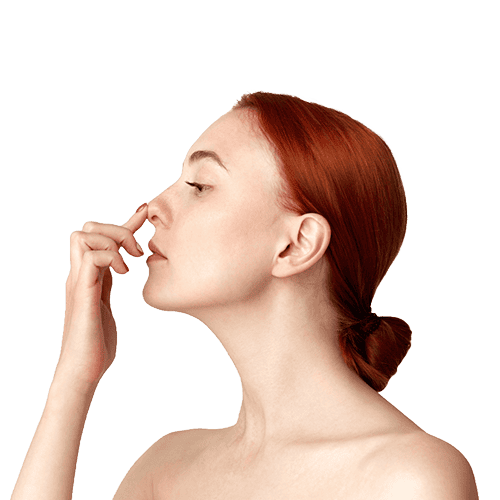Rhinoplasty
Rhinoplasty, also known as nose job, is one of the most commonly performed cosmetic surgeries, involving reshaping the nose to give it a new shape. The main goal of the patient is to change the shape or size of the nose that they are not satisfied with. Since the nose is an organ located in the middle of our face and is the most prominent area when we look in the mirror, it is not surprising that it is one of our main aesthetic concerns. Changing the shape of the nose will also change the expression and appearance. This is the reason for the desire for aesthetic rhinoplasty surgery.
Deformities in the shape of the nose can be caused by various reasons. These include genetic factors, developmental disorders in the bone and cartilage tissue during adolescence, or shape deformities resulting from trauma.
Another issue is breathing problems. This condition can be caused by many factors, including deviation (crookedness) in the nose, swelling in the nasal structures, and adversely affects the person’s daily life and quality of life. This is a condition that can be easily eliminated by intervening in the inside of the nose along with aesthetic correction in the same session. Having a nose that the person likes and breathing comfortably is the point where the nose patient reaches the peak of happiness.

Who is suitable for aesthetic rhinoplasty?
- Those with deformities in the nasal bone, tip, or shape
- Those who are not satisfied with the size of their nose and want to reduce it
- Those with a hump nose structure
- Those with a low nasal tip who want it to be lifted
- Those with differences or width in the nasal wings
- Those who think their nasal wings are wide and want to narrow them
- Those whose noses are broken due to trauma or accident
- Those with breathing problems who also want their nose shape to be corrected with this procedure
- Those who are healthy, have no general obstacle for the operation, and have realistic expectations
How many different types of rhinoplasty surgery are there and what are their different or advantageous aspects?
Regardless of the different names, terms, and newly discovered methods you may hear, there are basically 2 different methods. Open and Closed. It’s that simple. There is no clear superiority of one over the other. Surgeons follow their own path and use the technique they think is better. Some modifications can be made to the technique. The result depends on experience and skill.
In closed rhinoplasty surgery, all incisions are made inside the nose, some structures of the nose are preserved, there is no incision mark under the nose, and it is preferred more recently because it is considered to heal faster.
If you watch my video on this topic, you can get more detailed information.
Now let’s move on to our surgery process or what I consider to be a beautiful memory and adventure.
THE DAY OF SURGERY HAS COME.
We have had the necessary consultation before the surgery, planned how we can achieve the desired outcome, discussed the risks, and set the surgery date, and got our appointment. In the days before the surgery, you went to the hospital for a blood test and evaluation by the Anesthesia department. Everything is ready and under control.
On the morning of the surgery, you will come to the hospital on an empty stomach, having not eaten or drunk anything after midnight, and you will be taken to your designated room. An intravenous line will be placed, and you will be taken to the operating room at your scheduled time. Since the surgery will be performed under general anesthesia, you will not feel any pain.
The surgery will take between 2-3 hours, and after a short recovery period, you will be taken back to your room. When you fully come to, you will feel a fullness in your nose. There will be a silicone tampon inside your nose and a cast on your nose. Although you will not have pain at first, you will have some pain after the anesthesia wears off. Applying ice as described on your nose by your caregiver or yourself is very important to prevent swelling and bruising. You will feel much better after applying ice on the first day. You can start taking liquids orally 6-8 hours later. Since your intravenous line will be open, you will be given pain relievers and antibiotics. Necessary conditions will be provided for your comfort. After spending one night as a guest in the hospital, you will be examined by me the next morning, your prescription will be arranged, and you will be informed about what to do and what not to do before going home or to the hotel where you are staying.
In the first few days, there may be a discharge in the back of the nose and a desire to sneeze due to the tampon inside the nose. You should use the medications and sprays given to you. It is important to avoid straining or severe coughing in the early postoperative period. You should also be careful not to bend your head too far forward.
The silicone tampon in the nose will be removed at our clinic after 5-7 days. The cast on the nose will be removed 2-3 days later. You can now see your new but slightly swollen nose. The swelling in the nose will decrease over the months, and you will achieve the desired shape of your nose.
In the first 2 weeks, there may be bruising and swelling around the nose and face. These will pass quickly. The nose will reach the desired shape in 1 year.
Other points to be careful about:
- You can fly 10 days after the surgery
- Avoid sports for the first month and protect your nose from trauma
- Be careful not to bend your head forward
- Try not to use glasses for 3 months
Non-surgical nose job
Nose filler
Nose filler is a method that can be used in cases of depression at the junction of the nose and forehead, depression and irregularity on the nose bridge. It should not be applied to a patient considering surgery. When it dissolves and its effect disappears, only then can surgery be planned. Since there are many veins and nerve networks in the nose, especially a filler applied to the nasal veins can cause a nutritional disorder called necrosis. As a principle, I do not prefer nose fillers.
Nose botox
This method is very effective in some appropriate cases. It is suitable for the following patient groups:
- Those with widening of the nostrils during laughter
- Patients with downward movement of the nose tip during speech With the Botox application made in the appropriate muscle area and in the appropriate dose, the specific muscle group relaxes, and the nose tip changes position upwards or the excessive width in the nostrils decreases. The patient achieves a more natural nose appearance.
Nose thread lift
In recent times, it is seen that nose thread lift applications are performed to lift the nose. It should always be kept in mind that these applications may prevent subsequent aesthetic nose surgeries, their effects may be temporary, and there may be risks of reaction and infection.
